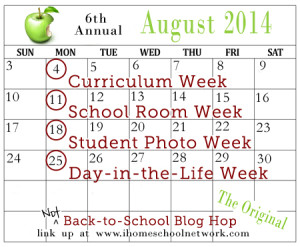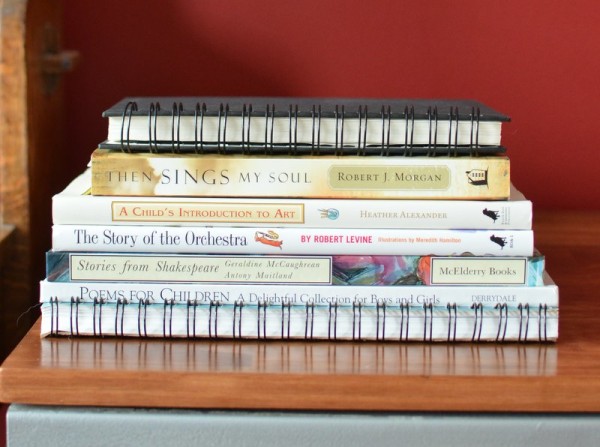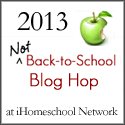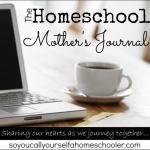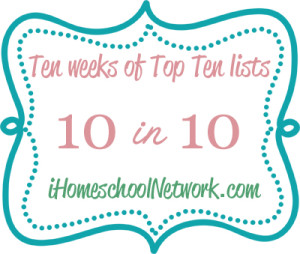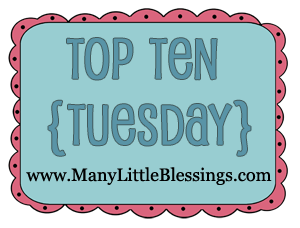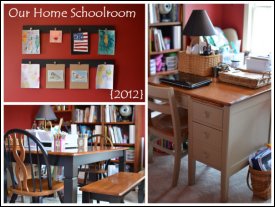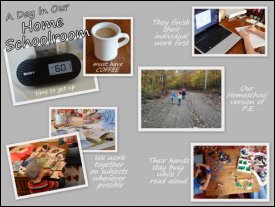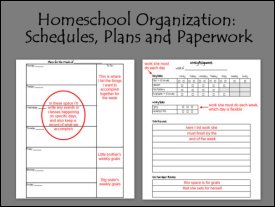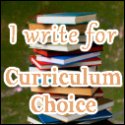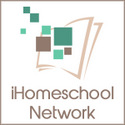 Hi, I'm Heidi and I homeschool my two sweet kids. I want them to know that learning is an exciting lifelong adventure! We love great books, unit studies, notebooking, lapbooking, and hands-on learning.
Hi, I'm Heidi and I homeschool my two sweet kids. I want them to know that learning is an exciting lifelong adventure! We love great books, unit studies, notebooking, lapbooking, and hands-on learning.Daily Homeschool Schedule
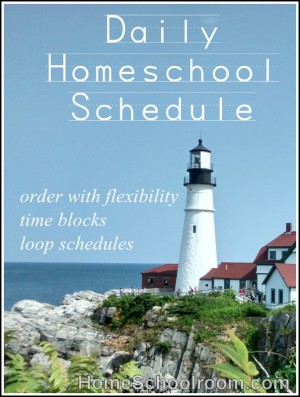
Want to follow along on a day in our homeschool? Let me share a bit about past year schedules, then we’ll get down to this year’s daily details.
A Brief History
My natural tendencies are to be a list-making drill sergeant task master. I can take the fun out of just about anything…but I’m maturing every year. This is our fourth year, and the history flows something like this:
- When I started homeschooling my kids (then ages 6 and 9) I planned our day on a spreadsheet with fifteen minute increments. I had a little icon showing which child I was working with. I spent a lot of time planning, and most of my plans were mom-intensive. I’m stressed just remembering it!
- By year two I ditched the small time slots, but still planned way too much, felt like I was running a dog-and-pony show, and never ever felt we had done enough.
- Our third year was much better. I learned to decrease my over-planning, stop making education “mom’s circus show,” and started working with blocks of time. I was finally finding the balance of a time-based schedule but with flexibility.
Ready to Start a New Year
Here we are at year four! I’ll still be using the scheduling that worked last year, like blocks of time, with a few extra things to keep me on track (and out of the stressed-out-and-grumpy-homeschool-mom category):
- When I am filling in our blocks, whether it’s individual work or the time we spend together, I make my guess of how long something will take and only fill 80% of each time block. This idea came from Sara at Amongst Lovely Things. It seems radical to a reformed over-planner driven to cross things off my list, and will hopefully help me be more realistic in how much I add to my list in the first place.
- I will make loop schedules for many of our time blocks. This idea came up in several blogs I was reading over the summer, and I realized it would help me be prepared for the blocks of learning we do together without having to plan those blocks each day or worry about whether we a certain block three days or four days on a particular week. I’m hoping it will also curb my tendency to feel “behind” if I don’t complete every block daily. (I’ll give a specific example of how a loop works in the details of our day.)
- In addition to having their list own lists of individual work, I will post our schedule each day so my children can see what we’ll be doing together. When reading about the way Charlotte Mason scheduled her students I recognized that I kept the plan for the day in my head or on my personal list. My kids were left not knowing what the day looked like ahead of time, having to ask me when they’d have time for personal activities, or being surprised by having to go run errands. That’s not fair, so I’ll be better about sharing my plan.
- Last but not least is what I call a “rolling start” to our mornings. I began this late last year, and it seems to be a magical way to have everyone work at their best. I’ll explain how this works in the details of our day.
After that lengthy introduction, let me share our daily flow which is broken up into orderly blocks of time. For details on what fills these time blocks (like my children’s individual work or what resources we use at Tea Time), see my post with our 2014-2015 Curriculum.
Morning Individual Work
This is where the rolling start comes in. We have two different mornings for my very different children: My daughter (age 12) has always needed a lot of sleep and is more alert in the evenings. My son (almost 9) is the quintessential early riser. He can’t do focused work later in the day, and even if he is up late he is still unbelievably alert and cheerful at 6 AM. After trying to start the school day together and either missing my son’s most alert time or dragging a groggy daughter out of bed and trying to get her to eat breakfast when she wasn’t hungry yet, I learned to be flexible.
Morning Schedule for My Early Riser
My son and I get up by 6:30. I am not naturally a morning person and must have coffee before conversation. My son knows this so he plays while I try to lift the fog. By about 7:30 he and I sit down to breakfast together. After that we head to my bed for his first Language Arts block: he reads to me (his least favorite work of the day), then I read to him from things like picture books or nonfiction books his sister is less interested in (about bugs or spies). Reading in my bed makes this time as pleasant as possible.
Then we both get dressed and tidy our rooms, meeting back downstairs by 9:00 to spend the next two hours on his individual work. Remember, though, that even though he has 2 1/2 hours blocked out for his individual work, I only plan two hours worth of work! If he works diligently he’ll have a little free time. I give him a list of his daily work, and in Charlotte Mason fashion I keep his lessons short and varied, and he knows what must be done and how long each lesson will be.
Morning Schedule for My Late Sleeper
I allow her to wake naturally or set her own alarm. Some people may think allowing her to sleep in is lazy, but I feel I’m letting her get what her body needs and using our flexibility to it’s best advantage. I will add that she is also is focused and works well independently. She works from a weekly list with the flexibility to complete subjects when she wishes as long as the work is done without complaining. One caveat is that any of her own work not finished by the time we start our blocks together will be done on her own time later in the day. I plan on her having about three hours of individual work (remember: only 80% planned).
11:00 Tea Time
At 11:00 we come together for Tea Time, where we share a sweet treat and beautiful things. We started this last year and it has been a huge hit. I’m expanding it this year because it worked so well for fitting in the “extras” that really matter, is a great transition between individual work and working together, and because it builds our relationships. This year, with us starting school at different times, it will hold extra importance as our sort of “morning meeting.”
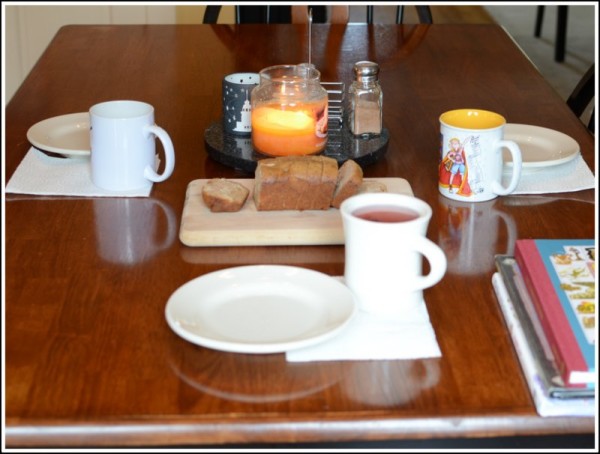
Here’s an illustration of how loop schedules work for our time blocks, using Tea Time as an example:
- Picture study
- SQUILT lesson
- Sketch Tuesday
- Listen to Classics for Kids podcast
- Poet Study
I can change the loop as needed, make a longer loop and add some things in twice if I want to do them more often…ultimate flexibility.
After we do the things that we do each time we sit down for Tea Time (like Bible reading), we just do the next thing on the loop. It helps because I don’t have to take time each day to figure out what we’ll do during Tea Time…I just do the next thing! And if we have a busy week and only have Tea Time twice that week I don’t feel I’ve missed things or am behind for the week.
11:45 Fresh Air
This is when I walk our dog. The kids can come with me, play outside in our yard, or play inside (in bad weather). This outside time is good for my health, necessary for our pet, and also gives my introverted brain a little break.
12:30 Learning Lunch
Again, my curriculum post details what might happen during our Learning Lunch. With our varied morning start times this is also when we watch CNN Student News (instead of at breakfast).
1:00 Together Time
This is when we work on the subjects that we do together with quite a bit of variety each day. I’ll use a loop schedule for this block, too. Frequently much of this time is spent reading aloud.
The Rest of the Day
By 2:00 my son is done his official schoolwork and goes off to pretend to be a secret agent or build a robotic ping pong ball shooter or heads outside to jump in leaves or snow, as the season dictates! My daughter will have individual work to finish and I’ll be available to her. I’ll usually try and take some time for my personal “Quiet Time” in my room where I read, write, plan…or just close my eyes and sit without anyone talking to me.
We’ll usually read aloud again later in the day from a chapter book for our book club or a just-for-fun book.
Disclaimer
Of course this is our typical at-home day, which is not an every day occurrence! Throw in extracurricular activities and errands, fun with friends and family, weather calling us to hike or build a snowman, or all those things that come with kids, pets and a home (The dog ate what? Everything in the freezer is melting?) and we often have atypical days. But it’s all good as long as we’re living and learning together!
Click over to the annual Day-in-the-Life blog hop to see how other homeschoolers plan their day!
2014-2015 Curriculum and Plans
I’m almost ready for the new school year to begin. We continue relaxed learning during the summer months, but come September we’ll resume our full-time schedule. (We never start before Labor Day–summer is short in Maine!). Here are my written-in-pencil plans for my nearly-nine-year-old boy and my just-turned-twelve-year-old girl.
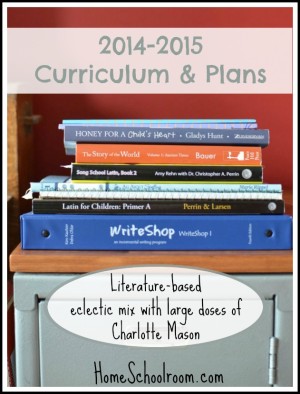
Before I start, let me say that I have made great progress in not planning too much, and it has improved the atmosphere of our homeschool. I also find myself aligning even more closely to Charlotte Mason’s ideas, which are a simplification of the subjects I tend to complicate. I have read some inspiring posts on planning and scheduling recently, which I’ll discuss more when I post our daily schedule. In short: I now indicate how long we will work on a certain subject in my plans.
Independent Work
In this case “independent” means the work each child is assigned that is not combined with their sibling. Some of it may be truly independent, some of it may be one-on-one work with me.
12-year-old Daughter (7th grade)
She will receive a weekly list of her independent work, laying down habits necessary for high school learning.
Math
- Teaching Textbooks: 30-45 minutes (usually one complete lesson) daily.
- Life of Fred: The story concept appeals to my daughter and I like approaching math concepts in another format for her. It was on the schedule last year but not done very often, we will try again this year.
Language Arts
- Writing: Daily for 30 minutes. This will take the form of a WriteShop lesson that we do together or her independent writing projects.
- Spelling: No formal spelling. We address misspelled words in her writing and that is enough for her.
- Grammar: She has requested more grammar. I’ll add it to her schedule to read one of our grammar books once a week (like Nitty-Gritty Grammar), and I’m looking for an editing practice book.
- Literature: Read 30 minutes daily from a literature list I’ve prepared using Ambleside Online, Honey for a Child’s Heart and Read for the Heart.
- Latin: Continue working on Latin for Children Primer A for 15 minutes daily. At the beginning of each chapter we watch the video together.
Music
- Continue with private piano lessons and practice 30 minutes daily.
Almost-9-year-old son (3rd Grade)
He will have a daily list to work from for his independent work, as he is not ready for a weekly list yet.
Math
- Teaching Textbooks: Daily for 20 minutes. I will continue to sit with him for the lessons, possibly transitioning to him working alone soon. He usually only finishes part of a lesson each day either the lecture or the problems. Charlotte Mason reminder: keep lessons short at this age.
- Math facts: Practices these through games and apps, try XtraMath this year.
Language Arts
- Reading: Daily for 30 minutes. He will read for 15 minutes, then I will read. He read to me daily last year, this year I am adding the time limit and reading to him. These are both intended to make this as pleasant a time as possible.
- Another 20 minute language arts session daily: we’ll work on All About Spelling (or a game like sight word bingo or ideas from Beechick’s Three R’s) and end with copywork. Two notes: All About Spelling is a program I purchased for my daughter but found it unnecessary for my naturally good speller. Now I see the tactile nature of the tiles are a great fit for my son. Also I stay close by for copywork to assure he does his best work.
- Literature: I also prepared a literature list for him. He will listen to audiobooks 20 minutes each day, and can play with Legos or play dough or something of the sort while he listens.
- Journal: We’ll continue keeping a journal to write back and forth to each other. This is usually done later in the day or at bedtime.
- Latin: We will listen to the songs from both levels of Song School Latin together before lunch. I will do some of the activities orally, but he will not do the written work.
Music
- Continue with private guitar lessons and practice 15 minutes daily.
Together Work
I combine subjects when possible. What wonderful relationships with each other and with learning it builds for our family! Our combined learning will be broken into three blocks: Tea Time, Learning Lunch, and a Together Block.
Tea Time
At 11:00 daily we will come together for a treat for bodies and minds. This was a new (and very popular) addition to the schedule last year, this year I’m expanding on it.
A few things will happen daily at tea time:
- Bible Reading
- Memory Work: we’ll work on memorizing scriptures, hymns, and poetry
- Poetry: we’ll read poems each day, sometimes choosing from an anthology, other times focusing on one poet for a while. I will also ask my daughter to choose poems some days and read them aloud to us.
These things will be on a loop schedule:
- Composer studies: We’ll take composers one at a time. We’ll read about their lives and play their music daily during tea time. When it comes up in the loop we’ll do a SQUILT (affiliate link) lesson for that composer.
- Artist studies: Similar to composer studies: learn about the artist’s life and art and do Charlotte Mason style picture study of one of the artist’s pieces when it comes up in the loop. I hope to collect nice art prints (old calendars are a good source) so I can have the piece on display.
- Sketch Tuesday: Barb posts a weekly theme at Harmony Fine Arts, then prepares a slideshow of all the sketches people send in. This is an art highlight for us.
- Poetry: When poetry comes around in the loop we’ll dig a little deeper into one poet and learn about his life, or learn about a particular style of poetry.
Learning Lunch
I like to make good use of my captive audience at lunchtime. These things will happen daily:
- Listen to Song School Latin chants as we prepare lunch. These are helpful even for my daughter, who had no Latin base before beginning Primer A.
- Watch Student News–keep a map handy to locate where stories are happening.
- Bedtime Math: a fun way to get my kids thinking about math outside their lessons. The part I like best is the focus on real-world problem solving and that they have to figure out what operation to use to solve the problem.
And we’ll finish out lunch with audiobooks or videos (documentaries, Horrible Histories, Beakman, Bill Nye, Science Friday, etc.).
Together Block
This is roughly an hour we’ll spend together after lunch and can be spent in a variety of ways.
History
We will continue to use SOTW as a framework (this year volume 2) but dig deeper using books from All Through The Ages. The kids will narrate. This can be a simple retelling (orally for my son, written for my daughter) or sometimes be done in more creative ways. Crafts and hands-on activities are to be done sparingly. (Remember, I’m a reformed over-planner!)
Science
We still will not use a year-long formal science curriculum, but science will be part of our school in many ways.
- Nature Study is a big piece of our current science education, mostly interest-led. We will continue keeping nature journals and aim for weekly entries except in the depths of winter. The subjects my kids choose are usually quite different. If my son has a snake for a while or my daughter brings in flowers to draw, they both learn from each other’s interests.
- Videos we watch during learning lunch bring up many other topics.
- I plan in-depth science units between history units. Last year it was the weather and the human body. This year I’m aiming for chemistry, but I’m not sure which resource I’ll use yet and it won’t happen until after Christmas, so I have time!
- Read alouds: Even science is literature-based. I read nonfiction books and scientist biographies aloud.
- Hands-on: We provide as many tools for hands-on exploration as possible. Microscopes and other real science tools, Snap Circuits, Lego Robotics. My son’s interests often lead to reverse engineering broken things: vacuum cleaners, blow dryers, music boxes…
- Outside classes: We will attend classes available in our area. I won’t be sure of these until the school year is up and running. A children’s museum and new planetarium at a university are both hoping to offer homeschool classes. As is often the case, these will be dependent on enough people signing up to attend.
Literature
Oh, how I love to read aloud with my children! I plan to continue the habit until they leave home. We will continue our relaxed book club with one other family, meeting whenever we’re done reading to discuss the books. Our children all keep Reader’s Response journals.
We’ve enjoyed three Shakespeare plays so far. I read them a retelling, then we see the play (live or recorded). We’ll hopefully do more of the same this year. Perhaps we’ll memorize a little Shakespeare?
Brain Breaks: I have to include this in our curriculum list because I’m so glad to have found this resource! Our Brain Breaks cards get very regular use in our homeschool.
Extracurriculars
We try not to run around too much, but we do have to get out and socialize, right?
- music lessons
- Scouts
- Homeschool Rollerskate once a month
- Possibly gym time at a local recreation department
- Field Trips: I love them! We try to join in on those organized by others, and have arranged a few of our own. The usual ideas like museums, historical sites, and performances (plays, orchestras) are great, and we also try places like wildlife sanctuaries and businesses…any place we can think of that would be interesting and willing.
Phew! I know that’s a long list, so I appreciate you reading all the way through.
Are you ready for the school year?
Summer (School) 2014 Plans
It’s summer in Maine! (Don’t blink or you’ll miss it!) Our regular daily schedule goes out the window in favor of relaxed summer days, but that doesn’t mean we stop learning. You can read my post on year-round schooling for the why of summer school for us, in this post I’ll tell you what that looks like this year.
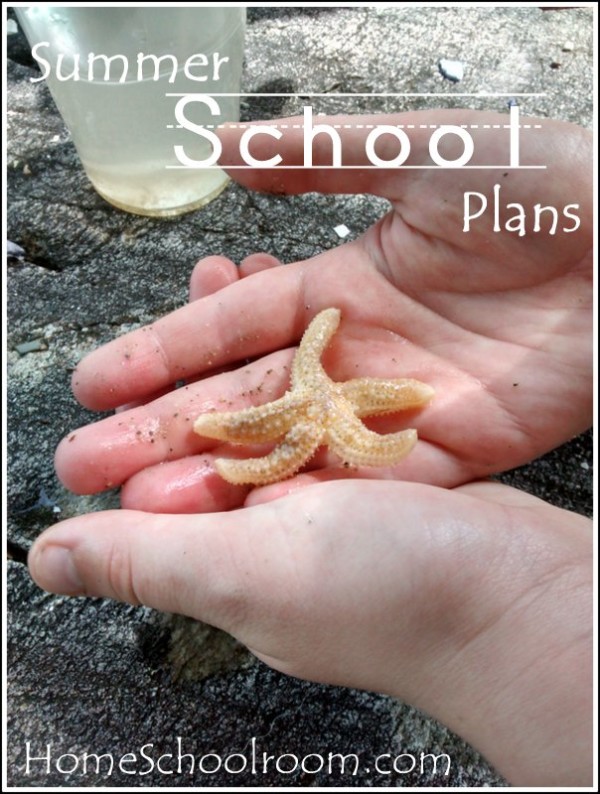
I am finding that I can loosen my reigns a little as my kids are becoming more independent learners and honing in on their own special interests. For my daughter that means plenty of time for playing piano, writing stories, and crafting (crocheting, shuttle tatting, sewing). For my son that means creative role playing, building (Lego & Lego Robotics, playdough, wood and nails…anything), and finding creatures outside.
Daily (Mostly) Independent Work
Within our relaxed schedule I keep a few required subjects going throughout the summer.
My 12-year-old daughter:
- Finish Teaching Textbooks Math 6 (less than 20 lessons left!)
- Daily piano practice (lessons continue in summer)
- Literature: read daily from a list of quality literature, her free reading is her choice
My eight-year-old son:
- Read to me (and most days a quick All About Spelling lesson right after)
- Daily guitar practice (lessons continue in the summer)
- Writing: He generally dislikes writing but enjoys a joint journal where he and I write back and forth.
Learning Together
The things we learn and do are very flexible during the summer. It involves lots of reading and taking advantage of opportunities that come our way–nature study when we’re camping at the ocean, visiting a farm on Open Farm Day, attending a Shakespeare play. I fit these in around summer fun, and chores like mowing the lawn and caring for the garden (which is a yet another learning opportunity).
History
I mentioned our school year had a bit of a soft ending, and part of that is due to our study of the Romans. So all of June and the early part of July are finding us still reading and marveling over the Roman Civilization. I want to hit on a couple more topics and maybe have a little end-of-unit celebration, then close the history books for the remainder of summer. The kids aren’t complaining a bit: today Julius Caesar was running around the house conquering (then sitting on his throne), and I acted as interviewer of Cleopatra for a video narration by my daughter.
Reading Aloud
We do a lot of reading aloud during the school year for history and science, plus a literary book club. Over the summer we’ll still read aloud together, with a theme of silly and sweet. Roald Dahl’s BFG and The Witches along with the Ramona books will take care of the silly. Then for sweet we’ll be reading Winnie the Pooh (which I keep hearing it is perfect for slightly older kids like mine), and perhaps Paddington Bear. I can’t tell you how much I love sharing stories with my children.
We also participate in our library’s summer reading program. The requirements are general and easily met by our regular reading, but my favorite parts are the special events like a puppet show and Mad Science show. I’ve also printed up the fun, free resources from Traveling Through The Pages Summer Reading Program. I like the requirements from different genres so I’m going to use this as a family reading program and see if we can complete all the squares and reward ourselves with some sort of prize.
Nature Study
We incorporate nature study regularly, but certainly it is easier during our warmer months. We camp at the seashore many times during the summer, and no matter how many times we go we always learn more. I’m trying out a couple new things this summer:
- In the past we’ve added nature journal pages to binders, but for fun this summer I bought nice hardcover sketchbooks for each of us.
- I’m not assigning what to draw, just requiring one drawing a week (and I’m including myself in the assignment–it’s good for me!). It’s more relaxed for me, and allows my children to follow their interests. My daughter often picks flowers while my son focuses on creatures.
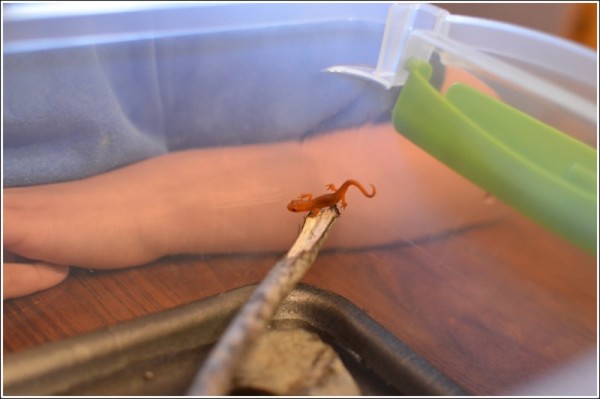
Another part of our summer nature learning is keeping temporary pets. We’ve done this before with monarch caterpillars and a katydid, but I’m focused on finding (or agreeing to) even more opportunities this summer. So far we’ve had a garter snake (that I was initially afraid to even touch), an Eastern Newt, and a Golden Ground Beetle. We learn so much by having them up close to observe, even just for a few days, and it really excites my critter-loving little boy.
Art
We love participating in Sketch Tuesday during the school year, and Barb is organizing a special summer art series on Picasso. Each Tuesday in July she’ll post an art project assignment based on one of Picasso’s works. My kids enjoy the slideshows Barb puts together of everyone’s projects, so this will be a fun way to keep art going over the summer.
So those are my relaxed summer learning plans. Just enough to keep our brains engaged but allow for lots of free time for my kids to pursue interests, and me to get rested up and geared up for next year!
How much do you plan your summer learning?
How I Teach Using an Eclectic Lifestyle of Learning
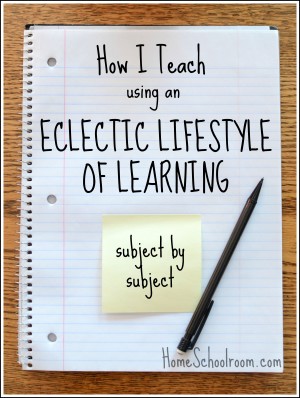
I love how homeschooling allows families with different homeschool philosophies, teaching styles, numbers and ages of kids, to tackle educating our children in the way that suits them. Care to see how it works around here? Then stay tuned as I plan to write about how I homeschool, subject by subject.
As an introduction today let me tell you a little about our family and philosophy:
Student #1: My Eight-Year-Old Son
A near carbon copy of his daddy, this little boy is like a lot of little boys: he loves science and math more than reading and writing. Working to read might not be his favorite thing, but he loves listening to me read aloud. He’s very imaginative and quite creative when problem solving. He can get very focused and lost in his work–when it’s of interest to him. He’d much rather use his brainpower to build things than worry about making sure he has his shirt on frontwards. His particular interests are military equipment and history, animals, learning to play guitar, Legos, robots and other technology.
Student #2: My Eleven-Year-Old Daughter
My girl is a bit of a mini-me. She has always loved reading and writing and thinks science is pretty interesting, but would avoid math if she could. She likes things predictable and organized and loves creating with her hands. Unfortunately I also passed down my tendency towards perfectionism and sweating the small stuff. We do have a couple big differences. She’s musically inclined–me, not so much. She’s an extrovert who loves being busy and engaged with others almost constantly. Me? Total introvert. Her particular interests are stories (reading literature, learning the stories of history, writing her own stories), handicrafts (sewing, knitting, duct tape…you name it!), and music (piano and choir).
Homeschool Dad, a.k.a. Mr. Technology:
My husband is my support. He not only financially supports us all, but listens to me, tells me I’m doing a great job, is willing to problem solve and jump in when we need help, and runs the technology side of our homeschool. I’m so thankful he can teach our kids things like computer programming and Lego Robotics. In addition to all that, he cooks for us!
Me, the Homeschool Mom:
I’m pretty much your classic type A: I struggle with perfectionism, micromanaging, and worry… BUT I’m really attempting to overcome these natural tendencies and slow down, relax and enjoy this lifestyle. The good news is that three years into homeschooling I’m making lots of progress learning to let go. Through homeschooling I have not only discovered my joy of learning, but become a complete homeschool mom dork–fascinated with everything and sometimes getting a little too excited to share it.
My Homeschool Philosophy:
My philosophy is fairly eclectic. If you want the nitty-gritty details on exactly what I mean by that you can read about what goes into my Eclectic Homeschool mix. The short description is a heaping helping of Charlotte Mason, a practical portion of Ruth Beechick, and bits of other techniques thrown in to suit the day, mood, topic or season. My big focus the further into this we get is turning this “homeschooling” thing into a lifestyle of education.
Join me for the next five days and I’ll share how I teach, subject by subject:
- How I Teach Homeschool Language Arts
- How I Teach Homeschool Math
- How I Teach Homeschool Science
- How I Teach Homeschool History
- How I Teach Homeschool Fine Arts
Subscribe via email or RSS, and feel free to pin this post–I’ll come back and update with links to the subject-by-subject posts each day!
I’m an Eclectic Homeschooler. What Exactly Does That Mean?
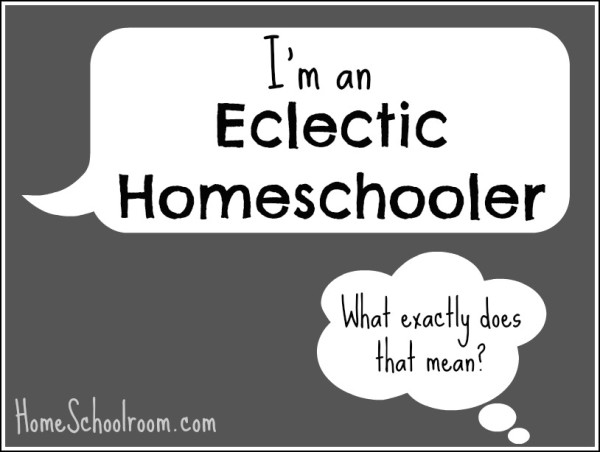
I like neat and tidy things, so sometimes I wish I could label my homeschooling philosophy with one of the catchy phrases that everyone would understand: classical, Charlotte Mason, interest-led, unit study, project-based learning, interest-led, unschooling…
Settling very comfortably into our third year I can’t help but call my style ECLECTIC. Since eclectic means “not following any one system but selecting and using the best elements of all systems,” that term doesn’t really help you understand how I go about educating my children. Yet I can’t avoid summing it up that way since I do, in fact, borrow bits that fit from different philosophies, and change techniques in different seasons and for different subjects.
If you’d like the long-winded description of my version of eclectic homeschooling, then read on for the parts of well-known philosophies that I use in our home schoolroom:
Charlotte Mason
This was the first philosophy that really caught my attention when I was researching homeschooling. I love the use of living books (quality literature written by an author with great interest in the subject) and incorporate her wonderful “extras” like poetry, classical music, fine art, nature study, and handicrafts. I also agree with her focus on habits, being sure the children have free time, and the idea of education as a lifestyle. I love the description I read recently in an article on Sage Parnassus, saying that Miss Mason viewed education as occurring “between a child’s soul and God.” Lovely.
If I had to choose one philosophy this would probably be it, but I am not enough of a purist to feel I can call myself a full “Charlotte Mason” homeschooler because of the areas where I borrow from other philosophies. Oh, and I’m known to frequently re-read a section of a book to my kids (she focused on the habit of attention and only one reading of a text) because someone can’t remember the important points. And sometimes that someone is me. My favorite book so far on this philosophy is A Charlotte Mason Companion by Karen Andreola.
Ruth Beechick
Over this past summer after feeling burnt-out all spring I read The Three R’s and You Can Teach Your Child Successfully by Ruth Beechick. You can read my full review on Curriculum Choice for the details on what I loved about her philosophy. The bottom line: her style is practical, and favors real books and real life over workbooks. Her advice gave me the confidence to avoid packaged curriculum for some subjects.
Whole-Hearted Learning
Educating the Whole-Hearted Child by Clay and Sally Clarkson was another book that provided much-needed inspiration last summer, and they call their philosophy “whole-hearted learning.” Again, their style bears the common theme of whole books versus workbooks. The best pieces I took from this book were the focus on family relationships, the heart of our children in their education, and our overall home environment.
Classical Education
There’s a touch of classical education in my homeschool soup as we study Latin and learn history chronologically, planning to cycle through historical periods more than once. I’ll admit I haven’t read a lot of the classical education literature, probably because I dislike the heavy concentration on memorization in the younger years. Though I like memorizing things that feed the soul, like hymns, Bible verses and poetry, memorizing large amounts of other information sounds like drudgery to me.
Traditional School at Home
We use a full math curriculum with chapters and quizzes (oh, how I love Teaching Textbooks) and I administer standardized tests to my children. My children study the full range of subjects, even if they don’t like a particular topic. We have a fairly structured school day and they are expected to complete all work I assign. We even have desks and a school room! However, I don’t hold strictly to grade levels (though my kids know what number to give people who ask), we shy away from worksheets and fill-in-the blank activities, and I don’t give any other tests or grades to my children.
Unit Studies
When we started homeschooling this was one of my primary techniques. We all loved it and have many fond memories of units we’ve done, but I use it far less now. Within history or science we’ll often spend a period of time on a certain topic, like the human body or Egypt, but I don’t tie in a lot of other subjects so we continue with our other learning each day. Why do I use them less now? My post about planning too much details some of the difficulties. The bottom line: in general I have to be careful not to orchestrate a show for my kids and to let their brains make connections with information. Now I reserve unit studies for when we’re taking a break from regular schoolwork during holidays or vacation weeks.
Interest-Led or Delight-Directed
I have more ideas than I can possibly cover in our school days, but I also work to allow time for my children to follow their interests. Homeschooling provides my children time in the afternoons and Fridays (I plan a four-day school week) to pursue their interests, so in essence part of their education is interest-led. We structure our home, time, and activities to encourage learning all the time. A big piece of this is making sure I provide resources: specialty supplies, books and videos, extracurricular activities and field trips.
Project-Based Learning
I’m intrigued with the idea of project-based learning (PBL), especially as my children are becoming older and more capable of diving into a topic and completing a project truly on their own. I’ve incorporated some PBL for my middle school daughter this year, allowing her to pursue a topic of interest with the expectation that at the end she shows us what she knows through some sort of project. I see this as a great way to work on passion for learning and independence. As such I see it’s true usefulness being in areas where the child has a natural interest, not as a way to cover all subject I deem necessary.
So there is my eclectic philosophy explained in a bit more depth. For some more long-winded explanations about how this style looks in our home, you can check out our 2013-2014 homeschool plans and how we structure our day to fit in all that matters to us.
2013-2014 Homeschool Curriculum and Plans
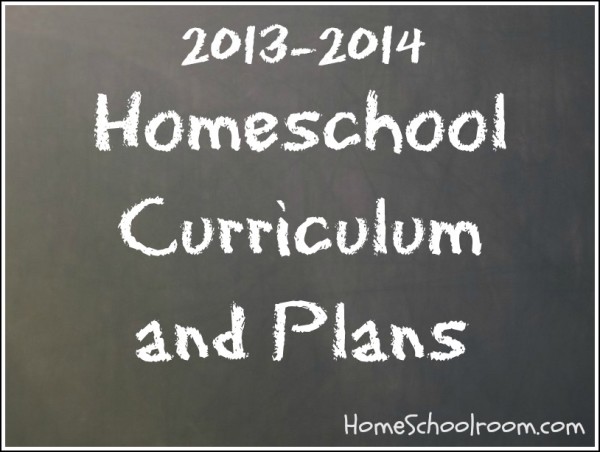
I continue shaping my homeschool philosophy and fine-tuning my methods as I educate my children. Before I go into my specific choices, these are the books that I’ve read over the summer that have had the greatest impact on my plans for this year.
This post contains affiliate links, but these are products I actually use and love.
- Ruth Beechick’s Books The Three R’s (Grades K-3) and You Can Teach Your Child Successfully (Grades 4-8): I devoured these immensely readable, practical books.
- Educating the Whole-Hearted Child by Clay and Sally Clarkson: This book is loaded with information and required digesting in pieces, but helped with the overarching purpose of all this work of homeschooling and the general family life we’re trying to create.
These books align with much of the Charlotte Mason literature-based philosophy that appealed to me since we started homeschooling, but have given me the confidence and practical ideas for applying those ideals in a real-life modern-day home(school). Instead of filling my shelves with expensive curriculum I’ll use temporarily, I will fill our shelves with terrific books that we can enjoy and turn to again and again for instruction and inspiration. So we’ll use little less curriculum and more living books; less elaborate activities to go with our studies and more time-tested techniques like copywork, dictation and narration.
Without further ado, here are my plans for our third year of homeschooling with my 11 year old daughter and almost 8 year old son:
Language Arts
Copywork and Dictation
I’ll use this powerful, simple tool to work on many aspects of language arts. No fancy program needed: I’ll choose sentences (or paragraphs) from books we’re using, meaningful scriptures, and quotes from people we’re studying. We’ll go over the sentence(s) together, discussing interesting words or grammatical features. Each of my children will use a simple lined notebook for our lessons. Ruth Beechick’s books provided information on the progressive steps of copywork and dictation as skills grow.
Spelling
I’ll use a personalized approach to spelling (detailed nicely in both of Ruth Beechick’s books and A Charlotte Mason Companion). My modern day tweak is to add their personalized lists into the Spelling Bee app for practice and testing.
Writing
- We already keep journals where each child and I write notes back and forth to each other. I’ll do a whole post on this sometime–it’s been a joy to me and one of our best writing practices. We’ll do more creative writing in the form things like a Christmas newsletter and letters to friends, and use ideas from my Language Arts Pinterest board.
- With my daughter, and possibly my son, too (though he’s a bit young) I plan to work through lessons in creative writing shared by Ami from Walking by the Way and Sarah from Small World at Home. They both posted wonderful lessons they used in a co-op setting and I think we’ll have lots of fun with this at home.
- The books I read over the summer left me feeling a bit empowered to not use a formal writing curriculum. However, nonfiction writing and essays are not the type of writing my daughter naturally gravitates to, so I will consider a formal curriculum to use part time to fill in gaps. We worked through Writeshop Junior D and I may jump into WriteShop I after the new year. The creative writing lessons should keep us quite busy until then!
- I do know that we will not use a formal grammar curriculum, but will just have a good grammar reference book that she learns to use well and work on grammar within her writing (not in a workbook).
Reading & Literature
- My son’s biggest goal is to increase his reading skills and my plan for that is very simple: he will read to me every day. We’ve been doing this over the summer, and not only is he improving a lot, he is really seeing the joy in reading.
- I will prepare a literature list for my daughter from Honey for a Child’s Heart and Read for the Heart. I’ll provide more choices than she needs to give her some options, but require reading a minimum of one chapter each day. She can choose her free-reading books (with oversight from me).
- My friend and I will hold a very informal book club of classic literature. Our families will read the books and meet to discuss them.
Math
Teaching Textbooks is the love of our math life.
- My daughter will begin Math 6. By the way, one of my fears when we switched was about its thoroughness and test scores dropping because of comments we’d read online. After working through all of Math 5 and our standardized tests I can say my fears are relieved and we are happily continuing with this computer-based program.
- My son will start Math 3. I am thinking we may need to break up lessons if they are as long as the Math 5 lessons were, but I have no problem letting him listen to the lecture at one sitting and doing the problems the next time.
With both children we also like to play with math through cooking or other real-life math and reading living math books.
History
After two years of American History (what fun we had!) it’s time to move into Ancient History. We’ll use Story of the World Volume I to keep us on track, adding in a lot of quality literature (using selections from the SOTW Activity Guide and All Through The Ages) and some extra hands-on fun from the Activity Guide only when it’s easy and educational. Remember, I’ve learned my lesson about over-planning.
Simple narration through notebooking will be how my children process and record what they’ve learned. I won’t be searching for fancy notebook pages: simple lined or unlined paper, or one of a few general notebooking pages I have available in a binder for them to choose from.
Science
We won’t use a formal curriculum but we will incorporate lots of science. I want to leave time to go with the flow because my son is loaded with science questions and curiosity. We’ve worked a lot on biology so it’s time to get messy with chemistry and have fun with physics. I have a multifaceted plan:
- I want to pick up some Janice VanCleave books (we have biology but I want to buy physics and chemistry), and we’ll try a free Susan Kilbride unit study on molecules (with the idea of purchasing her unit study book if I like the freebie).
- I bring our literature-based philosophy into science, too: we check out science books each time we visit the library, and I plan to read science books related to our history studies (All Through the Ages has suggestions for books on the history of science).
- We love fun science shows like Beakman and Mythbusters (both available free on Netflix) and extras like Science Friday videos (on Youtube).
- And don’t forget a hallmark of a CM education: nature study. I use the Outdoor Hour Challenges and other ideas from Barb’s wonderful blog and newsletter, use the Handbook of Nature Study as our spine, and jump into as many interest-led nature topics as we can (which is a little harder in January in Maine).
We’ll use the same simple tools of narration through notebooking that we use in history when applicable.
Art
This has been sorely neglected as I tended to plan large, elaborate projects. But this year I vow to be hands-on in art more regularly and here is how I plan to follow through:
- Drawing: I want to work on the simple art skill of drawing with my children. I often overlooked drawing feeling it was too easy or simple for me to focus on. But during many of our studies (history, science, nature) they use drawing to record observations. Not to mention that when we sit to draw together it is so relaxing! So I’m going to actually make drawing a subject this year (but be cautious not to sap the fun out of it). I’ll use Drawing with Children and Mark Kistler’s Draw Squad for instruction.
- Other than drawing I plan to get out art supplies once a week and just tell the kids to go for it: paint (watercolors, tempera, acrylic), pastels (chalk and oil), or clay (we adore Sculpey).
- I’ll also aim to do a lesson out of Storybook Art, Art Treasury, and my Art & Artist Study Pinterest board now and then to introduce them to new tools or techniques.
The Extras
I wrote about my plans for Tea Time to fit in the extras that add a lovely element to our homeschool. During our daily tea time this is what we’ll do:
- We’ll use Harmony Fine Arts Grade 5 plans to go along with our Ancient History studies. I love how easy it is to incorporate Charlotte Mason style art and music appreciation using Harmony Fine Arts plans. The Grade 5 plans are a little different than other years but will be extra fun because we’ll learn about ancient art and the beginnings of the orchestra.
- Mary from Homegrown Learners has made it very easy to incorporate great music in your homeschool with her SQUILT Music Appreciation Curriculum. Using the information from Mary and the technique of Super Quiet UnInterrupted Listening Time to study one great piece of music at a time is easy to implement, even for those of us with no background in classical music.
- We enjoy reading poetry aloud and I’ll continue with our relaxed style of reading from anthologies. We’ll also sometimes focus on one poet or style of poetry for short periods. When inspired we might try our hand at writing some of our own!
- I adore hymns and the beautiful history and messages within them. Mary from Homegrown Learners and Judy from Contented at Home shared wonderful ideas for hymn study.
Project Based Learning
My eleven year old daughter is ready for some truly self-directed learning, so I’m leaving room in her schedule for independent project-based learning. I’m still formulating my full plan, but I’ll be using ideas I’ve gleaned from Cindy at Our Journey Westward and Jamie at The Unlikely Homeschool.
Well, that’s is the super long-winded version of a peak into my homeschool plans. I’m linking up with iHomeschool Network’s blog hop for curriculum week. Hop over to check out other homeschooler’s plans and link up your own!
Homeschool Planning Pitfall: You Can Have Too Much of Good Thing
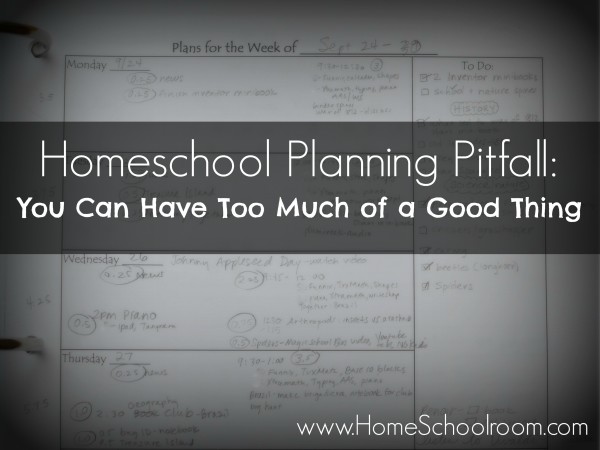
Since taking on the huge responsibility of homeschooling my children my natural personality trait of being task-oriented has been in overdrive. My tendency to obsess over details, set unattainable goals, and over-plan keeps my brain and body running at full speed trying to “get it all done.” During the last part of our school year I felt myself running on empty.
After the school year I took the time to review our curriculum choices and every aspect of our homeschool looking for successes and struggles. I went on a date with my my husband to ask his thoughts (I’m constantly sharing my thoughts with him). I interviewed each of my children separately. I read (or re-read) books that suit my homeschool philosophy.
I know that since life and my children are always changing I’ll never get everything “figured out,” but there are areas that need an overhaul, and a major one is planning. You know the saying, life is what happens when you’re busy making plans? Well, that could apply to my homeschool planning over the last two years. I spend way too much time researching, making lists, fretting and adding to our full plates. Being prepared and planning for your homeschool is a good thing, but I need to adjust how and what I plan.
Homeschool Planning Problem #1: Trying to Group All Topics Into Themes and Units
When I come across resources, whether books, videos, field trips, or anything else educational, instead of jumping in and enjoying it I struggle to pull all resources about the same topic together. I can spend an extraordinary amount of time researching books, activities and videos about a topic. This can actually lead to less time spent interacting with my kids (not to mention cleaning my house).
Here’s a typical scenario: My son asks when the bicycle was invented. Instead of answering his question with a simple web search or by checking out a library book I think: “Let’s do a whole unit on transportation!” I spend weeks pulling together ideas only to find he’s on to guitars.
Solution: Save themes and units for holidays and special occasions.
I will probably need frequent reminders to stop trying to group everything into tidy units. The themed unit studies with coordinating activities I see online look wonderful, but with my introverted personality and kids growing older, less me leads to more independent learning.
When students learn pre-selected information, pass a test, and receive a grade, they tend to feel that they have “finished” a subject. They close the door on that chapter, soon forget a large part of the information, and have no open questions that they intend to search out answers for. So as teacher, you do not have to be an “answer giver.” That should take pressure off practically all of us.” ~Ruth Beechick in You Can Teach Your Child Successfully
Instead of trying to group everything, I need to trust my children’s ability to make connections with information they learn.
The ideas required for the sustenance of children are to be found mainly in books of literary quality; given these the mind does for itself the sorting, arranging, selecting, rejecting, classifying.” ~Charlotte Mason (vol 6 p. 117)
Homeschool Planning Problem #2: I plan elaborately.
This problem goes along with my desire to make units out of everything: I tend to go overboard and I can spend as much (or even more) time planning as our lessons take. I strive to find every resource on a given topic. I try to learn information ahead of time to then teach to them in an engaging way, with preparation for hands-on activities, printing and cutting out minibooks, or finding the right notebooking page. I’m wearing myself out and losing the joy of learning alongside my children. I can even feel a bit offended if they don’t “ooh” and “aah” over my facts or techniques.
If your children sense that you are more concerned about the structural details of your unit than you are about the joy of learning, they will not be free to learn. If you are uptight, they will be uptight. If it becomes a test of your teaching ability, it’s time for a change.” ~Clay & Sally Clarkson, Educating the WholeHearted Child
Solution: Stop trying to put on a show for my kids.
I need to stop planning elaborate lessons and activities that are more entertainment than education. After years of leading Girl Scouts and teaching Sunday School and throwing themed birthday parties I still planned homeschool like that. But this is now our life and it needs to run differently. I realize I’m actually doing my children a disservice because it allows them to be passive.
The whole thing must be highly amusing to the teacher, as ingenious amplifications self-produced always are: that the children too were entertained, one does not doubt. The teacher was…in fact, acting a part and the children were entertained as at a show.” ~Charlotte Mason (Vol 6 p. 116)
In fact, I have so many thoughts on the labor-intensive activities I was planning that I’ll have to address that in another post.
Homeschool Planning Problem #3. I plan more than we can complete.
I’m very prone to this both in my personal to-do lists and in our schoolwork. I get caught up in the details and what I think we need to be doing. So many ideas look interesting, educational, fun, worthwhile and even necessary. The more resources I find the more I add to my list of things to do. Add to that curious kids and a dad who likes to jump in with ideas and I always plan too much.
Though it’s great to not run out of ideas, planning more than we can do leaves me feeling behind. I feel overwhelmed even though they’re always learning and making progress. I loose the joy of discovery and learning and just notice what didn’t get crossed off my list. I go to bed at night fretting over what I didn’t do that day, and wake up up in the morning with a heavy feeling that there is too much to do that day.
Solution: Pin it and forget it.
The internet is a wonderful resource, but I see so many good ideas that I over plan or feel we aren’t doing enough. Going forward, I vow to add ideas to my Pinterest boards so they are there for inspiration, then let them go. (If you have the same problem but aren’t on Pinterest, just substitute paper lists, browser bookmarks, or however you save ideas.)
This doesn’t mean I won’t ever do those great activities and use those great resources, just that they won’t be on my list of “have to dos.” They’ll be there when I need them—not lost but not required. So many things are good but we can’t do everything! And I’ll remind myself that as long as we’re learning every day all is well. Focus on making progress and enjoying life, not worrying about what didn’t get done.
Many thinkers have stated that it is better to study less and learn it well than to study more and learn only superficially.” ~Ruth Beechick in You Can Teach Your Child Successfully
I hope sharing my struggles helps some other planning-till-you-drop homeschool mom. And hopefully putting it in writing will hold me accountable to simplify my planning and rely more on great literature to be the teacher for my children.
I’ll let you know how I do, okay?
Successful Start to Summer Schooling
Summer school is fully underway, hooray! I’ve made my notes to just leave June alone next year, and plan on a July start of more structured learning. That way I don’t feel “late” or “behind.”
We’ve been using the weekly checklists I made for the kids since early June and earlier this month started working away at our summer curriculum plans. I purposefully didn’t plan a lot of formal schoolwork, but tried leaving us open for relaxed learning. As a die-hard planner I wondered if this would work or if learning wouldn’t happen if I didn’t have it all written in my lists. The good news is we’ve learned a lot without me planning and directing everything! (Shocker, I know.)
Nature Study
Two new-to-us insects from nature found us this week:

My father-in-law brought this magnificent luna moth specimen to us. He shared a lot of information with us, and I later found this YouTube video of the luna moth life cycle that has wonderful footage of the moth and equally wonderful explanations of all the things that make it so interesting! We realized how lucky we were to see one, since they are nocturnal and adults only live one week. By the way, the adult luna moth doesn’t eat–at all. It comes out of the cocoon just to reproduce and die.

Another day I was mowing and noticed these wart-like growths on some maple leaves. I envisioned a crawly little insect or worm hatching out, so we put a few leaves in the bug catcher for observation…nothing happened. After a Google search I discovered they were galls formed by a mite that overwinters in the bark of the tree. The leaf produces the little pouch-like galls that surround the mite, which continues to live, feed, and breed within the gall. Luckily it isn’t likely to damage the trees. Insects are fascinating!
Science
We attended a Mad Science presentation sponsored by our library called “Dig Into Science: Journey to the Center of the Earth.” It was an interactive, action-packed hour where we all learned a little something.
Reading Aloud
We have been completely entranced by the Chronicles of Narnia. I’m reading the books aloud (starting with The Magician’s Nephew) and after we finish each one we’re listening to the radio dramatization from Focus on the Family (which is superb, by the way). I really wanted to read the series, but was a bit worried after all of us disliked The Hobbit. I wondered if we were fantasy-challenged but we all love this story.
Educational Television Viewing
My daughter has always enjoyed the “Dear America” books, and we stumbled across Dear America videos on Netflix. There are 12 half-hour episodes: nine are historical fiction stories from American history, three are the “Royal Diaries” versions that tell of a famous princess. I highly recommend them! They’re perfect for relaxed summer learning and have led to great discussions and role-playing the characters and time periods in their free time.
And a side note: I’ve talked about learning to loosen up on my themes and let go of my constant attempts to keep topics neatly grouped together. The old me would have written down this great resource and tried to use each video at its appropriate time in our history studies. The I’m-still-learning-to-let-go me not only let my children go ahead and watch Cleopatra (even though we’ll be studying her next school year) but I didn’t even require they watch the videos in order chronologically. How’s that for progress?
We are enjoying our new favorite science show, Mythbusters (many episodes also available on Netflix). My son loves the show and it really inspires him to experiment. For instance, on one show they were testing vehicles in tornado-force winds. The rest of the afternoon my son built Lego vehicles and tested them in wind. We played around with fans and a blow dryer to get the strongest wind. (And when I heard the leaf blower of the lawn company working down the street the crazy homeschool mom in me was tempted to ask to borrow it.)
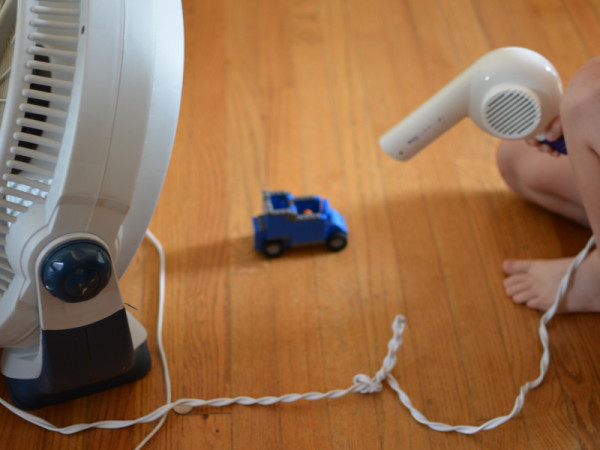
My favorite part of the show is how they model that everything doesn’t always work perfectly on your first try–often something fails and you have to try and try again!
Art
I shared our wire sculpting based on the book Norman the Doorman. Trying out a completely new art medium was great fun for all of us.
I have another homeschool experiment–if less planning can still mean a lot of learning, will this work in the area of art, too? Our art supplies are conveniently located in a big hutch near our kitchen, but neither of my children tends to get them out unless I’m directing a specific art project. I tried a little experiment one hot afternoon and got out the watercolor paints, telling them to paint whatever they wanted.
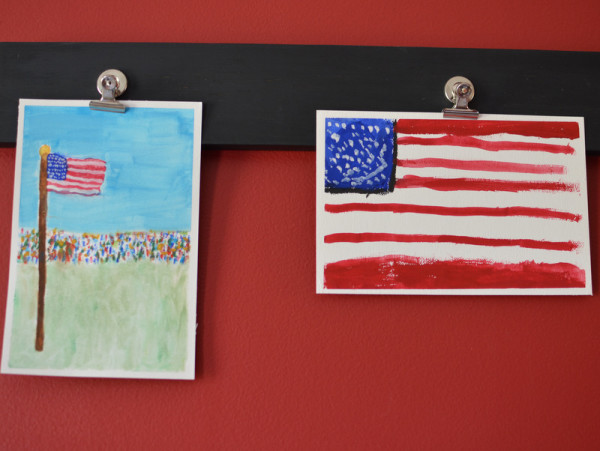
It worked wonderfully! This isn’t to say that I don’t want to do art projects with instructions for learning skills, but I think I’ve overlooked the importance of also giving them time to just create on their own.
And All The Other Things That Summer Brings!
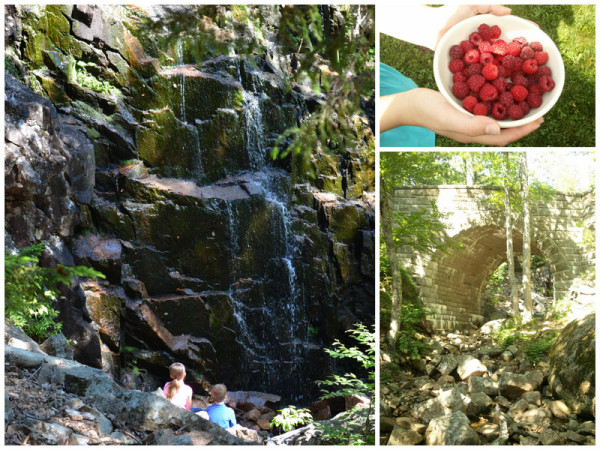
We hiked to a waterfall in Acadia National Park, walking on the historic carriage roads part of the way. Our summer goal is 10 new adventures, meaning a hike or visit to a lighthouse we’ve not seen before. This is number three checked off! I feel good about that progress. And speaking of progress, we’re beginning to see some produce from our gardens. Not enough to make jam or anything, but some raspberries made a delicious snack!
Have you been working on summer goals, either educational or just for fun?
Thank you to the wonderful hostesses with wrap-up link-ups. Be sure to join the fun and see what other homeschoolers are up to!
2013 Summer School Plans
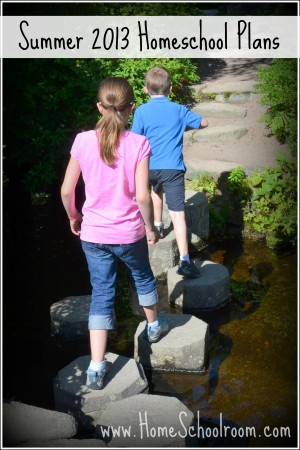
It’s our third year of summer schooling since that first summer we started our homeschool journey.
Our first summer we did a few big unit studies: the Revolutionary War, wildflowers and the ocean. They were a fun start to homeschooling with my little almost six year old boy who didn’t want to sit still and my barely 9 year old who had just finished public school second grade.
Our second summer I planned too much: some core curriculum work for both kids along with beginning full science and history curricula that I planned to continue with in the fall. It wasn’t a bad summer, but I never felt I got as much done as I wanted and just continuing on with those same items in the fall wasn’t a very refreshing transition.
So here we are in summer number three. I love year round schooling, but I’m taking a bit more relaxed approach this summer. Though I’m always adjusting in our homeschool I felt ready for some real examination of my techniques and tactics before next year. A few things need tweaking as we grow into our homeschool skin and my daughter enters the middle school years. I’ve been reading and re-reading and thinking and re-thinking. In the meantime I’m taking it fairly light on formal schoolwork for the summer.
Independent Summer Schoolwork
Both Kids
We’re making good progress on making their chores and certain responsibilities happen without a lot of reminders from me using our summer schedules.
11 Year Old Daughter
On her checklist for schoolwork she is required to read and practice piano daily, do XtraMath and typing twice a week, and we’re starting a Life of Fred Fractions lesson once a week. She uses Teaching Textbooks during the year, so we’re trying LOF as a fun summer supplement.
7 Year Old Son
My son’s biggest goal is to practice reading! After finishing Funnix (my review on Curriculum Choice here) I kept fretting about whether he needed more formal curriculum for reading. He just wants to read, and read fun books (not leveled readers with a boring story). A post by one of my favorite bloggers, Heather of Blog She Wrote, reassured me that just reading is the best next step. So that’s what we do nearly every day. And I still read to him from both picture and chapter books.
What We’ll Work on Together
History
We’ve just started What Every Child Needs to Know about Western Civilization from Brimwood Press. So far I’m really impressed by this ingenious history program. We’re spreading this out over the summer, and it is a perfect break from our labor intensive history studies. This is open-and-go for me: just some reading aloud and looking at pictures is giving us a better view of the overall flow of history. Lovely. (I’ll write a full review soon.)
Science
We were so history-focused last year that my science-loving son has asked for more science. Especially experiments that call for goggles. So here we go! This may look like a lot, but they’re all just flexible topics that we do when time and desire presents itself.
- Nature Study: Okay, so we don’t usually need goggles in nature study, but my boy does love bugs and the outdoors. We’ll continue to use Barb’s ideas at the Handbook of Nature Study blog (be sure to subscribe so you get her newsletter) and just try to dive in and learn about things that find us.
- Snap Circuits: My son is also quite tech-obsessed, so we’re working through a study of electricity with lots of hands-on fun using our Snap Circuits kit. I wrote a review on Curriculum Choice of the kit and the student guide we’re using.
- Human Body: I have a bunch of resources for a human body study that I pulled together last fall when my kids were asking questions about how our bodies work. I hate to say all the great books did nothing but sit on the shelf, but I hope to crack them open this summer. My approach will be more relaxed than what I first planned: pretty much read and look at pictures, and do a fun hands-on observation, dissection, or experiment when they’re interested and it’s easy. I think a few could involve goggles.
Art
I’m planning to jump in for another great resource from Barb, also known as Harmony Art Mom. She usually posts Sketch Tuesday assignments with a topic to draw. This summer she’s posting all kinds of different art projects, and anyone is free to send in photos of their finished work and she puts them all in a slideshow.
Another goal for art this summer is to just get out the supplies once in a while and let them create without direction from me. Crazy, huh?
Reading Aloud
I think the thing I will miss most when my children grow up and move out is reading aloud together. I know my daughter, at 11 years old, still looks forward to our reading times. Our first (big) goal is the entire Chronicles of Narnia…we’re already on the second book and loving it.
So that’s the plan. An hour here and there throughout the week accomplishes our relaxed summer learning, with lots of time left for being outside, camping, swimming, hiking, playing, creating, and following interests as they come up.
10 Homeschooling Books to Encourage and Equip
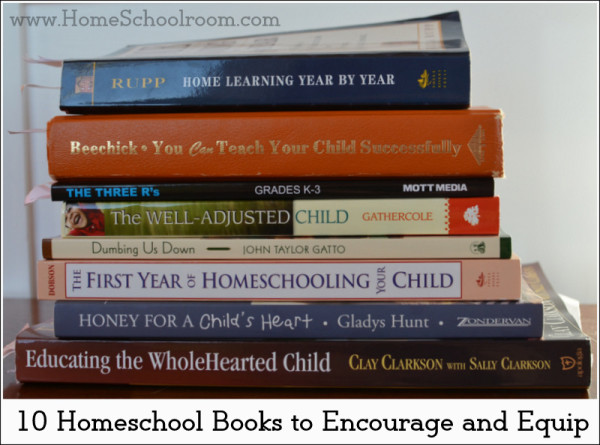
It’s time for another Top Ten post and the topic this week is homeschooling books. I am by no means an expert in this area and still wish I could take a month off just to read more books about homeschooling! In fact, that’s what I’ve been doing since we officially finished our school year about a week and a half ago. I want to share some of my favorites, which fall into two categories: the books that encouraged me to homeschool and those that equipped me to do it.
By the way, the book titles are Amazon Affiliate Links, but these are books I truly enjoyed.
#1 The Well-Adjusted Child: The Social Benefits of Homeschooling by Rachel Gathercole
Don’t laugh, but one of my arguments against homeschooling (you know, before I became one of those weirdos) was that kids had to go to school for socialization. My husband ordered several books when I was hyperventilating over the prospect of homeschooling and this was the first book I read. It opened my eyes to the fact that a bunch of same age kids in a room doesn’t lead to the kind of social skills I’m looking to create.
#2 Dumbing Us Down: The Hidden Curriculum of Compulsory Schooling by John Taylor Gatto
This was my second book, and my second a-ha moment. This was the one that I kept stopping as I was reading and remarking to my husband that we had to homeschool! It’s a fairly quick read at around 100 pages but really highlighted for me the negative aspects that can be found in public schools. (For example, changing subjects to the ringing of a bell makes no sense whatsoever in the real world.)
#3 The First Year of Homeschooling Your Child by Linda Dobson
Now that the first two books had convinced me that I did, indeed, want to homeschool my children, this was the first book I read that made me think I could actually accomplish it. My favorite parts of the book were many stories from homeschool families and the examples of different homeschool philosophies so I could begin to formulate my plan for educating my children. The book also deals with a lot of practical newbie help like taking a child out of public school (and the de-schooling that can be necessary) and learning styles.
#4 Home Learning Year by Year by Rebecca Rupp
This is another very practical choice. There is a chapter for each grade from preschool through high school, and each one details a course of study and even lists resources for covering the subjects. I continue to refer to this book, especially for math concepts to see that we’re covering age-appropriate skills. I appreciate the wide range of resources listed, from books to manipulatives to games to standard curriculum.
#5 Honey for a Child’s Heart by Gladys Hunt
Okay, so this isn’t actually a homeschooling book, but it had an impact on my homeschooling style and continues to be a reference I turn to so I wanted to list it here. Like the Read Aloud Handbook by Jim Trelease (which I also enjoyed, but comes in second to this book) it encourages reading aloud to children and sharing books as part of your family life. The first portion of the book discusses books and their importance, how to encourage your children to read and choosing books. The second half of the book contains book lists organized by age and topic. I have come to really trust her choices and the paragraph describing each book.
#6 Charlotte Mason’s Original Homeschooling Series
Though I am fairly eclectic in my homeschooling I admire many of Charlotte Mason’s philosophies and incorporate as much of them as I can. I have to admit I have not finished reading all six books in her original series. This is reading I save for when my brain is fresh and focused. I purchased the Kindle version once when it was available for around a dollar on Amazon so it was very little to spend to have her writing easily accessible. When I get a chance I read a few pages and I also use the highlight feature to keep track of particularly interesting or beneficial sections. Her original series and modern paraphrases are available for free online at Ambleside.org.
#7 For the Children’s Sake by Susan Schaeffer Macaulay
This book gave me an tremendously helpful overall idea of Charlotte Mason’s philosophy and helped me better understand the primary focus areas of her method. Understanding those primary areas gave me direction in planning my homeschool priorities.
#8 A Charlotte Mason Companion by Karen Andreola
This book is quite a bit longer but filled with practical advice on implementing every part of a Charlotte Mason style education. I read a copy from the library but intend to add it to my bookshelf so I can highlight and stick sticky notes in it and refer to it.
#9 Educating the WholeHearted Child by Clay and Sally Clarkson
I’d had my eye on this book for a while after reading many accolades, but was holding off because it wasn’t available at the library. I finally bought a copy and am glad I did–it is a large book loaded with information on many aspects of child-rearing and homeschooling. It is very much Christian-focused, which would come as no surprise to anyone familiar with the Clarksons. Their homeschool method has much in common with Charlotte Mason, and this book has a very practical modern-day focus for raising children today. My favorite parts are the focus on living books, natural and gentle education methods, and making your home work for your in your goals.
#10 The Three R’s and You Can Teach Your Child Successfully by Ruth Beechick
These are my newest reads and they easily joined my list of favorites. I found myself getting a little bogged down this year in long to-do lists and obsessing about curriculum choices and schedules. Ruth Beechick’s advice is so very practical and down to earth it would be hard not to be calmed by her style. The Three R’s covers Kindergarten to 3rd grade, while You Can Teach Your Child covers grades 4-8. Going over these books has already helped me simplify some of my plans for next year.
I love reading homeschooling books to fine-tune my style and encourage me in this lifestyle. What books have you loved that I should add to my summer reading pile?
I can’t wait to read the book lists of the other bloggers of iHomeschool network. Every Tuesday for the next 10 weeks I’ll be participating with the other bloggers of iHN in a blog hop of top ten lists.
This blog hop series was inspired by Angie of Many Little Blessings where you’re welcome to link up, too!
